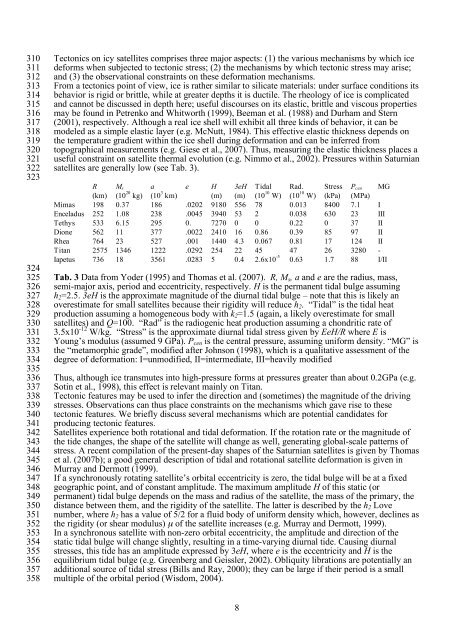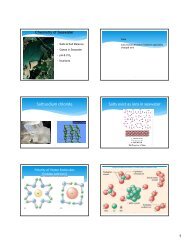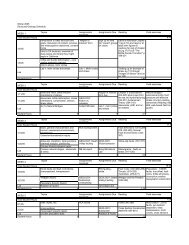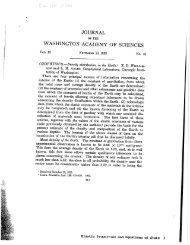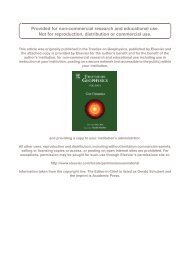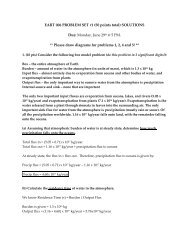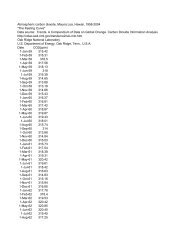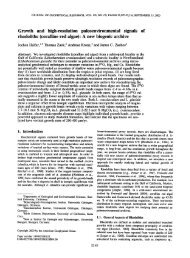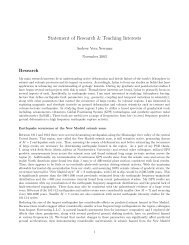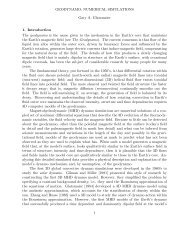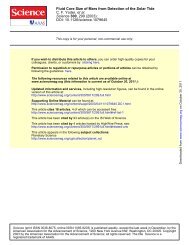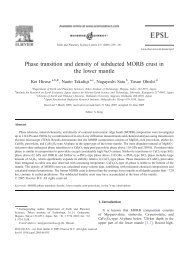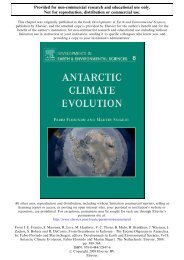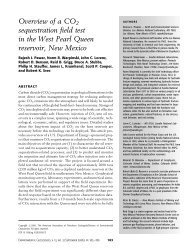Reprint - Earth & Planetary Sciences - University of California, Santa ...
Reprint - Earth & Planetary Sciences - University of California, Santa ...
Reprint - Earth & Planetary Sciences - University of California, Santa ...
Create successful ePaper yourself
Turn your PDF publications into a flip-book with our unique Google optimized e-Paper software.
310 Tectonics on icy satellites comprises three major aspects: (1) the various mechanisms by which ice<br />
311 deforms when subjected to tectonic stress; (2) the mechanisms by which tectonic stress may arise;<br />
312 and (3) the observational constraints on these deformation mechanisms.<br />
313 From a tectonics point <strong>of</strong> view, ice is rather similar to silicate materials: under surface conditions its<br />
314 behavior is rigid or brittle, while at greater depths it is ductile. The rheology <strong>of</strong> ice is complicated<br />
315 and cannot be discussed in depth here; useful discourses on its elastic, brittle and viscous properties<br />
316 may be found in Petrenko and Whitworth (1999), Beeman et al. (1988) and Durham and Stern<br />
317 (2001), respectively. Although a real ice shell will exhibit all three kinds <strong>of</strong> behavior, it can be<br />
318 modeled as a simple elastic layer (e.g. McNutt, 1984). This effective elastic thickness depends on<br />
319 the temperature gradient within the ice shell during deformation and can be inferred from<br />
320 topographical measurements (e.g. Giese et al., 2007). Thus, measuring the elastic thickness places a<br />
321 useful constraint on satellite thermal evolution (e.g. Nimmo et al., 2002). Pressures within Saturnian<br />
322<br />
323<br />
satellites are generally low (see Tab. 3).<br />
R<br />
(km)<br />
Ms<br />
(10 20 kg)<br />
a<br />
(10 3 km)<br />
e H<br />
(m)<br />
3eH<br />
(m)<br />
8<br />
Tidal<br />
(10 10 W)<br />
Rad.<br />
(10 10 W)<br />
Stress<br />
(kPa)<br />
Mimas 198 0.37 186 .0202 9180 556 78 0.013 8400 7.1 I<br />
Enceladus 252 1.08 238 .0045 3940 53 2 0.038 630 23 III<br />
Tethys 533 6.15 295 0. 7270 0 0 0.22 0 37 II<br />
Dione 562 11 377 .0022 2410 16 0.86 0.39 85 97 II<br />
Rhea 764 23 527 .001 1440 4.3 0.067 0.81 17 124 II<br />
Titan 2575 1346 1222 .0292 254 22 45 47 26 3280 -<br />
Iapetus 736 18 3561 .0283 5 0.4 2.6x10 -5 0.63 1.7 88 I/II<br />
324<br />
325<br />
326<br />
Tab. 3 Data from Yoder (1995) and Thomas et al. (2007). R, Ms, a and e are the radius, mass,<br />
semi-major axis, period and eccentricity, respectively. H is the permanent tidal bulge assuming<br />
327<br />
328<br />
329<br />
330<br />
h2=2.5. 3eH is the approximate magnitude <strong>of</strong> the diurnal tidal bulge – note that this is likely an<br />
overestimate for small satellites because their rigidity will reduce h2. “Tidal” is the tidal heat<br />
production assuming a homogeneous body with k2=1.5 (again, a likely overestimate for small<br />
satellites) and Q=100. “Rad” is the radiogenic heat production assuming a chondritic rate <strong>of</strong><br />
3.5x10 -12 331 W/kg. “Stress” is the approximate diurnal tidal stress given by EeH/R where E is<br />
332<br />
333<br />
Young’s modulus (assumed 9 GPa). Pcen is the central pressure, assuming uniform density. “MG” is<br />
the “metamorphic grade”, modified after Johnson (1998), which is a qualitative assessment <strong>of</strong> the<br />
334<br />
335<br />
degree <strong>of</strong> deformation: I=unmodified, II=intermediate, III=heavily modified<br />
336 Thus, although ice transmutes into high-pressure forms at pressures greater than about 0.2GPa (e.g.<br />
337 Sotin et al., 1998), this effect is relevant mainly on Titan.<br />
338 Tectonic features may be used to infer the direction and (sometimes) the magnitude <strong>of</strong> the driving<br />
339 stresses. Observations can thus place constraints on the mechanisms which gave rise to these<br />
340 tectonic features. We briefly discuss several mechanisms which are potential candidates for<br />
341 producing tectonic features.<br />
342 Satellites experience both rotational and tidal deformation. If the rotation rate or the magnitude <strong>of</strong><br />
343<br />
344<br />
the tide changes, the shape <strong>of</strong> the satellite will change as well, generating global-scale patterns <strong>of</strong><br />
stress. A recent compilation <strong>of</strong> the present-day shapes <strong>of</strong> the Saturnian satellites is given by Thomas<br />
345 et al. (2007b); a good general description <strong>of</strong> tidal and rotational satellite deformation is given in<br />
346 Murray and Dermott (1999).<br />
347 If a synchronously rotating satellite’s orbital eccentricity is zero, the tidal bulge will be at a fixed<br />
348 geographic point, and <strong>of</strong> constant amplitude. The maximum amplitude H <strong>of</strong> this static (or<br />
349 permanent) tidal bulge depends on the mass and radius <strong>of</strong> the satellite, the mass <strong>of</strong> the primary, the<br />
350<br />
351<br />
352<br />
distance between them, and the rigidity <strong>of</strong> the satellite. The latter is described by the h2 Love<br />
number, where h2 has a value <strong>of</strong> 5/2 for a fluid body <strong>of</strong> uniform density which, however, declines as<br />
the rigidity (or shear modulus) µ <strong>of</strong> the satellite increases (e.g. Murray and Dermott, 1999).<br />
353 In a synchronous satellite with non-zero orbital eccentricity, the amplitude and direction <strong>of</strong> the<br />
354 static tidal bulge will change slightly, resulting in a time-varying diurnal tide. Causing diurnal<br />
355 stresses, this tide has an amplitude expressed by 3eH, where e is the eccentricity and H is the<br />
356 equilibrium tidal bulge (e.g. Greenberg and Geissler, 2002). Obliquity librations are potentially an<br />
357 additional source <strong>of</strong> tidal stress (Bills and Ray, 2000); they can be large if their period is a small<br />
358<br />
multiple <strong>of</strong> the orbital period (Wisdom, 2004).<br />
Pcen<br />
(MPa)<br />
MG


